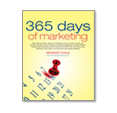Ah, the paper cutter—that oh-so-useful tool with its machete-like blade that sits way up on that shelf in the copy room.
We actually like it when we have a chance to use it. It’s kind of therapeutic, even fun. We get to figure out how to line things up perfectly to get the cut exactly where we need it, it saves us time and work, and it’s really efficient when it comes to doing what it was designed to do.
So we take it out, wipe the dust off, use it to trim the edges off whatever it is we’re creating, then we lock the blade back up and put it back up on the shelf until we need to use it again.
That’s how you use the paper cutter, but it’s no way to use marketing.
But unfortunately, it’s exactly how marketing is utilized in many small and even not so small businesses. You know who you are.
You’re the one who pulls the marketing tools off the shelf because that wunder-product that you thought would fly off the shelves, didn’t. So now, only at the end of the process, do you whip out some marketing in a last-ditch effort to sell a few units before you have to put it back on the clearance table.
If you are wondering what’s wrong with that model, I can help. Here’s what marketing can do for you when you give it a seat at your business process table every day:
- Working with your most valuable clients and/or members of your ideal client types to determine their most important needs and wants, so that purchasing decisions are more informed.
- Test marketing before you spend precious resources and allocate valuable shelf space to new products.
- Setting up a focus group to identify what product benefits (and selling points) resound most powerfully with members of your target market.
- Seeding the market to get pioneers and early adopters on board and talking about the product.
- Creating demand and anticipation among customers before the product arrives with teasers that speak to the identified real needs and wants of your customers across multiple communication and social media channels.
- Running a strong launch campaign across all of your marketing channels.
- Sharing product testimonials on print and in-store displays, in email marketing and on social media.
- Doing in-store sampling.
- Creating promotions for the product which represent genuine value to customers (and which are also profitable for your business).
Look how many marketing tools can – and should – be used before the product even arrives or the new service is made available to customers!
It’s much more difficult to create strong sales momentum around a new product or service after the fact! In fact, at that point, you have skipped several steps that are critical to the process, not the least of which is determining whether there is even demand for the product or service you want to introduce.
But in many businesses, the sales manager, operations manager and purchasing director sit down with manufacturers and buy product, receive it, stock it and put it on the shelves. Only then do they hand marketing a product brochure and tell them that it’s up to them to get it sold.
In many businesses, thousands and thousands of dollars are spent purchasing sophisticated phone systems, customer service reps (who, for some inexplicable reason, report to accounting, rather than sales) are hired and a significant amount of time and resources are invested in training them on the technicalities of answering a phone call, inputting an order, putting a caller on hold or transferring a call -- but next to no time or resources are spent actually training them in communications and customer relations.
In many businesses, new techniques or even whole new services are learned, pricing set, menus and signage updated and then service professionals find themselves sitting around twiddling their thumbs, waiting for the phone to ring. Only then is marketing informed that they need to get people in the door to use the new service.
In many businesses, the controller comes up with what he thinks is a great new policy relative to how customers pay, register, check out or are invoiced. He writes a terse, accountant-like script and slaps it on a display for the cash register, sends it out in letters to all your customers and puts notes in bright red on all customer invoices (so they won’t miss it).
Only after a barrage of angry customer phone calls, dropped accounts, unsubscribe requests and other missives is marketing appealed to for damage control. All of which could have been avoided, had marketing and a customer-centric mind been part of the process and policy review process, part of the policy writing process, and part of the customer communications process.
Your paper cutter approach to marketing demonstrates not only that you don’t value or understand marketing, but it also demonstrates a serious deficit in terms of how important you believe your customers are, based on how little they factor in to your operational processes.
It’s obvious when a business employs a paper cutter approach to marketing.
And it’s just as obvious that it costs those businesses, big time, over time, in blown opportunities, poor customer relationship management, lost sales, diminished profits – it all adds up, doesn’t it?
***
 Elizabeth Kraus is the author of 365 Days of Marketing.
Elizabeth Kraus is the author of 365 Days of Marketing.365 Days of Marketing is available on amazon.com or save $5 off the list price when you use the Code USH9VPJG and purchase on my site at 12monthsofmarketing.net.











0 comments:
Post a Comment